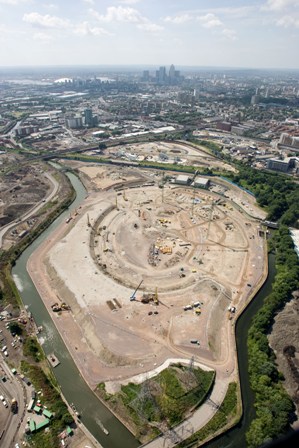One year into the build, the Olympic stadium takes shape [photo: ODA]
Rising in the east
One year after construction began, London’s Olympic stadium is taking shape and being discussed in polite company. The Leisure Review reports on progress to date.
One year into the build, the Olympic stadium takes shape [photo: ODA]
Mid-May marked the first anniversary of the start of construction work on the Olympic Stadium and the Olympic Delivery Authority (ODA) marked the occasion with a little low-level hoopla in the form of some press statements, some new photographs and a site visit for aspiring 2012 competitors. Within the context of the full 2012 timeline it was a comparatively small milestone but the London 2012 family noted it nonetheless. Some disinterested observers were inclined to note the fact that the ODA felt able to draw attention to its achievement as the most significant element of the event.
If one stands in Stratford, an eastern outpost of the capital city soon to be the centre of the sporting world, there seems to be a new perspective. From here it is noticeable that it has all gone quiet to the west. The perennial high-earning high achievers of the City have shut up and, in many cases, shut up shop. In Westminster the Members of Parliament who missed or ignored all the warning signs along the road to economic meltdown are facing another financial crisis of their own making, this one rather closer to their own homes. Now the background noise of reproach that has accompanied the progress of London 2012 from bid to building has quietened. Now there is a new understanding of what constitutes an acceptable use of public funds and Olympic critics are a little more difficult to find. London’s Olympic vehicle is beginning to look more like a bandwagon than a tumbril and the ODA and LOCOG, the London organising committee for the Games, can put their heads above the parapet to talk about the stadium that is rising in the east.
John Armitt, chair of the ODA, marked the anniversary with reference to progress towards the Games and life afterwards. “One year on from the start of the ‘big build’ the Olympic stadium is on track and already becoming a feature of the east London skyline.” he said. “The steady and safe progress is a credit to the team on site and their suppliers across the UK. The stadium is on schedule to host the opening ceremony of the London 2012 Games in just over three years time and become a high-quality facility in legacy for athletics and other sports.”
Seb Coe, chair of LOCOG, echoed the point regarding the ambitions of legacy. “The Olympic stadium will become the heartbeat of the Olympic park in 2012 and home to spectacular sport, not just at Games time but for years to come,” he said. “It has been a fantastic effort to get us this far but the future promises much more. A spectacular Olympic Games and Paralympic Games in 2012 and when the Games have left town we will have changed the map of East London for good, bringing a regenerated area and multi-sport facilities for both elite and community use – including track and field.”
The stadium timeline runs through to the summer of 2011, when construction is scheduled for completion. By the anniversary date the construction team had installed over 4,500 reinforced concrete columns to support the stadium structure. Twelve of the twenty-eight roof compression trusses, each weighing 85 tonnes, had been put in place and 105 of the 112 rakers which act as terracing supports in the upper tiers, had been fixed. More than 5,000 of the 12,000 pre-cast concrete terracing units were in place and some 400 workers were on site, a figure that will increase to around 600 as the internal fit-out progresses. This internal fit-out has now begun, dividing the space below the stands into the 700 rooms and separate areas required for the stadium to function as a fully operational venue. Among these 700 spaces will be eight changing rooms and the indoor warm-up track below the west stand. The fit-out will use 11,000m of drainage pipes, almost 340,000m of power cables and 12,000m of ventilation ducting. Getting to this point has involved shifting 800,000 tonnes of soil and 10,000 tonnes of steel. The stadium’s island site covers 40 acres and when complete the stadium will measure 53m at its highest point.
There are few who doubt that the team working on the London Olympic Stadium – which includes HOK Sport (now known as Populous) as architect, McAlpine as construction contractor, Buro Happold as structural and building services engineer, HED as landscape architect and Savills Hepher Dixon as planning consultant – will deliver a remarkable building. In twelve months time we may be better placed to judge what impact it will have on the Games in 2012 and on the sporting future of East London for decades to come.
The Leisure Review, June 2009
© Copyright of all material on this site is retained by The Leisure Review or the individual contributors where stated. Contact The Leisure Review for details.
Above: the stadium island, May 2009
Below: the stadium island, twelve months earlier